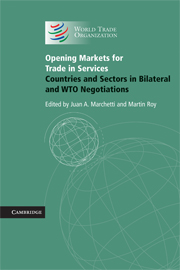Book contents
- Frontmatter
- Contents
- List of figures
- List of tables
- List of boxes
- List of contributors
- Foreword
- Acknowledgments
- Disclaimer
- Summary and overview
- PART I From Policy to Negotiations
- PART II Multilateral and Bilateral Negotiations on Services: Overall Perspectives
- PART III Challenges, Issues and Opportunities in Services Sectors
- PART IV Country Experiences with Services Trade
- 14 GATS plus or minus? Services commitments in comparative contexts for Colombia and Uruguay
- 15 Opening services markets at the regional level under the CAFTA-DR: the cases of Costa Rica and the Dominican Republic
- 16 Why isn't South Africa more proactive in international services negotiations?
- 17 Services liberalization in PTAs and the WTO: the experiences of India and Singapore
- 18 The domestic dynamics of preferential services liberalization: the experience of Australia and Thailand
- 19 The Chilean experience in services negotiations
- Appendix: A reader's guide to basic GATS concepts and negotiations
- Index
- References
15 - Opening services markets at the regional level under the CAFTA-DR: the cases of Costa Rica and the Dominican Republic
Published online by Cambridge University Press: 05 December 2011
- Frontmatter
- Contents
- List of figures
- List of tables
- List of boxes
- List of contributors
- Foreword
- Acknowledgments
- Disclaimer
- Summary and overview
- PART I From Policy to Negotiations
- PART II Multilateral and Bilateral Negotiations on Services: Overall Perspectives
- PART III Challenges, Issues and Opportunities in Services Sectors
- PART IV Country Experiences with Services Trade
- 14 GATS plus or minus? Services commitments in comparative contexts for Colombia and Uruguay
- 15 Opening services markets at the regional level under the CAFTA-DR: the cases of Costa Rica and the Dominican Republic
- 16 Why isn't South Africa more proactive in international services negotiations?
- 17 Services liberalization in PTAs and the WTO: the experiences of India and Singapore
- 18 The domestic dynamics of preferential services liberalization: the experience of Australia and Thailand
- 19 The Chilean experience in services negotiations
- Appendix: A reader's guide to basic GATS concepts and negotiations
- Index
- References
Summary
The cases of Costa Rica and the Dominican Republic (DR) offer interesting examples of why smaller countries choose to negotiate in a regional context, and help explain why the CAFTA-DR regional agreement has led both of them to make services commitments that go significantly beyond their WTO GATS schedules.
The story of regional opening in both countries must be prefaced by the following details at the outset, however. Not all regional negotiations are identical and not all regional partners have the same ability to extract a high level of engagement. Services trade negotiations are fashioned by the political and economic environment in which they take place and they encompass an international component and a domestic element. Governments can use trade negotiations to take advantage of the outside pressure offered by these processes to mobilize public support and domestic groups for their objectives. They may also build coalitions and alliances with other parties or transnational actors to enhance their chance of achieving their preferred outcome. This process seems to be easier to achieve in a regional context than in the multilateral context of the WTO negotiations for a variety of reasons, the most obvious one being the lack of focused external pressure and the absence in the multilateral context of clearly identified benefits traceable to desired objectives.
When negotiators encounter adversity at home and strongly entrenched vested interests for the opening of certain sectors, however, building such coalitions may prove extremely problematic, to the point that achieving the services commitment may be impossible without a huge component of external pressure that can be exerted either in the form of the enticement of a very large market or the clout of a very powerful trading partner.
- Type
- Chapter
- Information
- Opening Markets for Trade in ServicesCountries and Sectors in Bilateral and WTO Negotiations, pp. 537 - 572Publisher: Cambridge University PressPrint publication year: 2009
References
- 1
- Cited by



